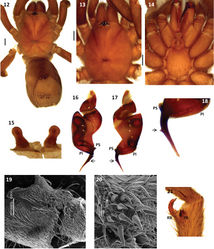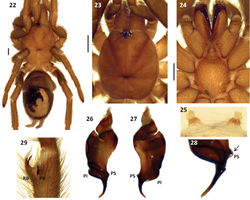Melloleitaoina yupanqui
| Notice: | This page is derived from the original publication listed below, whose author(s) should always be credited. Further contributors may edit and improve the content of this page and, consequently, need to be credited as well (see page history). Any assessment of factual correctness requires a careful review of the original article as well as of subsequent contributions.
If you are uncertain whether your planned contribution is correct or not, we suggest that you use the associated discussion page instead of editing the page directly. This page should be cited as follows (rationale):
Citation formats to copy and paste
BibTeX: @article{Perafán2014ZooKeys404, RIS/ Endnote: TY - JOUR Wikipedia/ Citizendium: <ref name="Perafán2014ZooKeys404">{{Citation See also the citation download page at the journal. |
Ordo: Araneae
Familia: Theraphosidae
Genus: Melloleitaoina
Name
Melloleitaoina yupanqui Perafán & Pérez-Miles, 2014 sp. n. – Wikispecies link – ZooBank link – Pensoft Profile
Material examined
Known only from types.
Type material
Holotype male from Argentina, Jujuy, P. Nacional Calilegua, Seccional Aguas Negras, 605m above sea level (GPS), 23°45'43.3"S, 64°51'04.7"W (± 10m, WGS84), 06-11-xii-2008, C. Grismado, M. Izquierdo, F. Labarque, G. Rubio, M. Burger, P. Michalik, P. Carrera, A. Ojanguren and C. Mattoni leg. (MAC-Ar 26041). Paratype female, same data as the holotype (MAC-Ar 26044).
Diagnosis
Male differs from other Melloleitaoina species by the palpal bulb morphology with a discontinuous PS, formed by two separate keels, very curved embolus without triangular tooth, well-developed PI and PS, and apex widened (Figs 26 and 28). Female differs from other Melloleitaoina species by the shape of the spermathecae with short seminal receptacles with large granules (Fig. 25).
Description
Holotype male (MAC-Ar 26041): total length, not including chelicerae or spinnerets, 9.3, carapace length 4.3, width 4.0. Color (in alcohol): cephalotorax, legs light reddish brown, cephalotorax with few brown and golden setae, legs darker, mainly femora, abdomen brown with a patch of urticating setae golden brown. Anterior eye row slightly procurved, posterior slightly recurved. Eyes and interdistances: AME 0.17, ALE 0.22, PME 0.12, PLE 0.16, AME-AME 0.088, AME-ALE 0.033, PME-PME 0.36, PME-PLE 0.022, ALE-PLE 0.055, AME-PME 0.022, ALE-ALE 0.39. OQ length 0.75, width 0.55, clypeus 0.022. Fovea transverse, procurved, width 0.68. Chelicerae with 11 well-developed teeth on furrow promargin, 8/10 small teeth on the proximal area of furrow. Labium length 0.48, width 0.88, with 8 cuspules. Maxillae with 53/51 cuspules. Sternum length 2.0, width 2.0. Tarsi I-IV scopula widely divided. Tarsal claws with 2 small teeth on proximal half, near the inner edge. Sparse scopulae on metatarsi; metatarsus I scopulate on distal half, II scopulate on distal third, III only apically scopulate, IV without scopula. Tibia I with prolatero-ventral distal apophysis with two very unequal branches (Fig. 29); PB very short with basal spine, much longer than branch, RB curved, around ten times bigger than PB with internal medial spine that exceeds the length of branch. Metatarsus I slightly curved, flexion on RB. Femur III thickened. Type III-IV intermediate urticating setae present. Palpal organ piriform with the embolus very curved, two prolateral keels (PI and PS) present, discontinuous PS, formed by two keels, apex widened (Figs 26–28).
Spination. Femora: 0. Patellae: 0. Tibiae: palp 0; I 1P; II 0; III 2V, 2P, 1R; IV 4V, 2R. Metatarsi: I 1V; II 1V; III 6V, 3P, 1R; IV 8V, 1P, 2R. Tarsi: palp, I-IV 0.
Legs and palpal segments lengths (femur/patella/tibia/metatarsus/tarsus). Palp: 2.4/1.3/1.9/0.7 total 6.3; I: 3.9/2.2/3.3/2.7/1.7 total 13.8; II: 3.6/2.0/2.6/2.4/1.7 total 12.3; III: 2.9/1.4/1.8/2.5/1.6 total 10.2; IV: 4.6/1.7/3.6/4.9/2.2 total 17.0.
Paratype female (MAC-Ar 26044): total length, not including chelicerae or spinnerets, 10.6, carapace length 4.9, width 4.0. Color (in alcohol): as in male, but lighter. Anterior eye row slightly procurved, posterior slightly recurved. Eyes and interdistances: AME 0.17, ALE 0.31, PME 0.19, PLE 0.21, AME-AME 0.08, AME-ALE 0.04, PME-PME 0.31, PME-PLE 0.022, ALE-PLE 0.044, AME-PME 0.066, ALE-ALE 0.39. OQ length 0.81, width 0.66, clypeus 0.022. Fovea transverse, procurved, width 0.71. Chelicerae with 9 well-developed teeth on furrow promargin, 15/14 small teeth on the proximal area of furrow. Labium length 0.55, width 1.1, with 8 cuspules. Maxillae with 90/87 cuspules. Sternum length 2.1, width 2.1. Coxae III and IV with spiniform setae on promargin (as Figs 19 and 20). Tarsi palp, I-IV scopula widely divided. Tarsal claws with 2 small teeth on proximal half, near the inner edge. Sparse scopulae on metatarsi; metatarsus I scopulate on distal half, II on distal third, III and IV without scopula. Type IV urticating setae present. Spermathecae with two short seminal receptacles with large granules (Fig. 25).
Spination. Femora: palp 1P; I 1P; II 1P; III 1P, 1R; IV 0. Patellae: palp 0; I 0; II 0; III 1P; IV 0. Tibiae: palp 4V; I0; II 0; III 5V, 2P, 2R; IV 5V, 2R. Metatarsi: I 2V; II 2V; III 9V, 3P, 2R; IV 7V, 2P, 2R. Tarsi: palp, I-IV 0.
Legs and palpal segments lengths (femur/patella/tibia/metatarsus/tarsus). Palp: 2.5/1.6/1.7/1.6 total 7.4; I: 3.3/2.2/2.5/1.8/1.4 total length 11.2; II: 2.9/1.9/2.0/1.7/1.4 total 9.9; III: 2.6/1.5/1.7/2.3/1.4 total 9.5; IV: 3.7/1.7/2.8/3.3/1.7 total 13.2.
Etymology
The specific epithet is a patronym in honor to the most important Argentine musician of folklore Atahualpa Yupanqui, pseudonym of Héctor Roberto Chavero Aramburu (Juan A. de la Peña, Argentina, 1908 – Nimes, Francia, 1992).
Original Description
- Perafán, C; Pérez-Miles, F; 2014: Three new species of Melloleitaoina Gerschman and Schiapelli, 1960 (Araneae, Mygalomorphae, Theraphosidae) from northern Argentina ZooKeys, 404: 117-129. doi
Images
|

